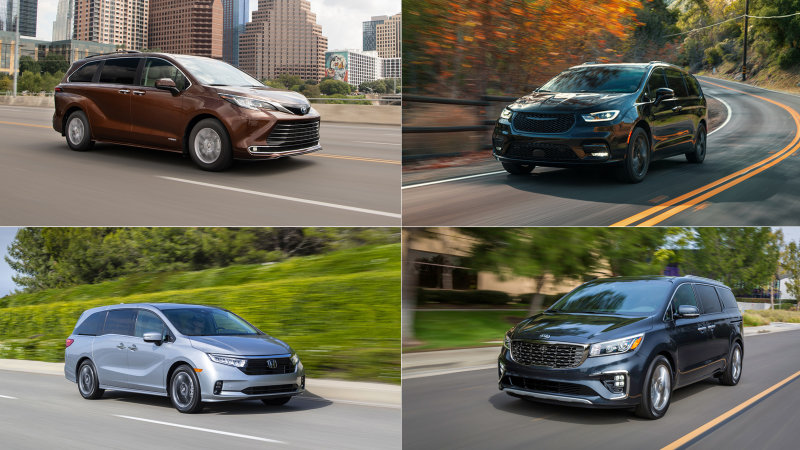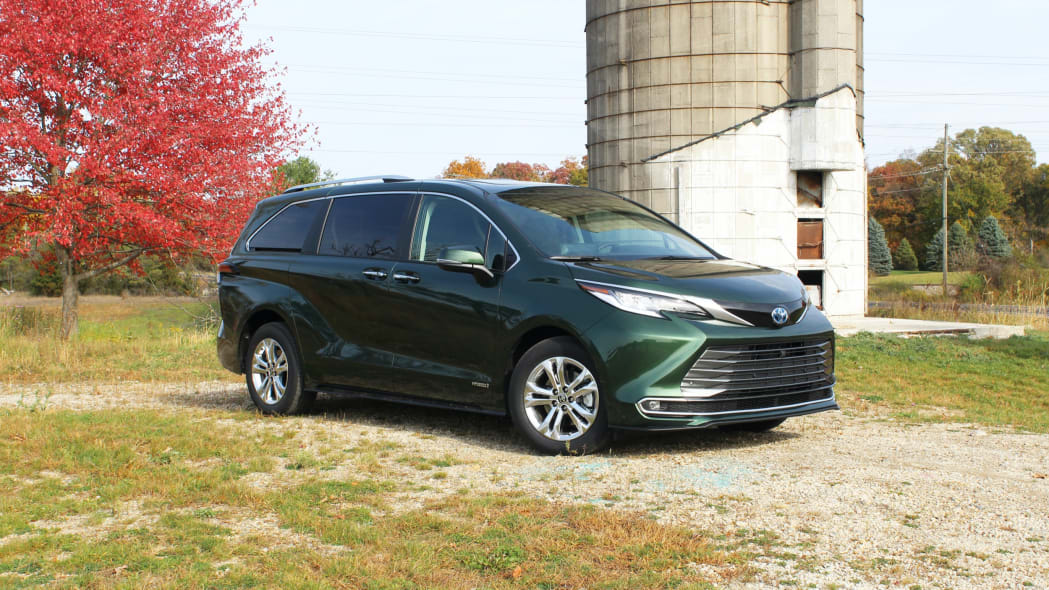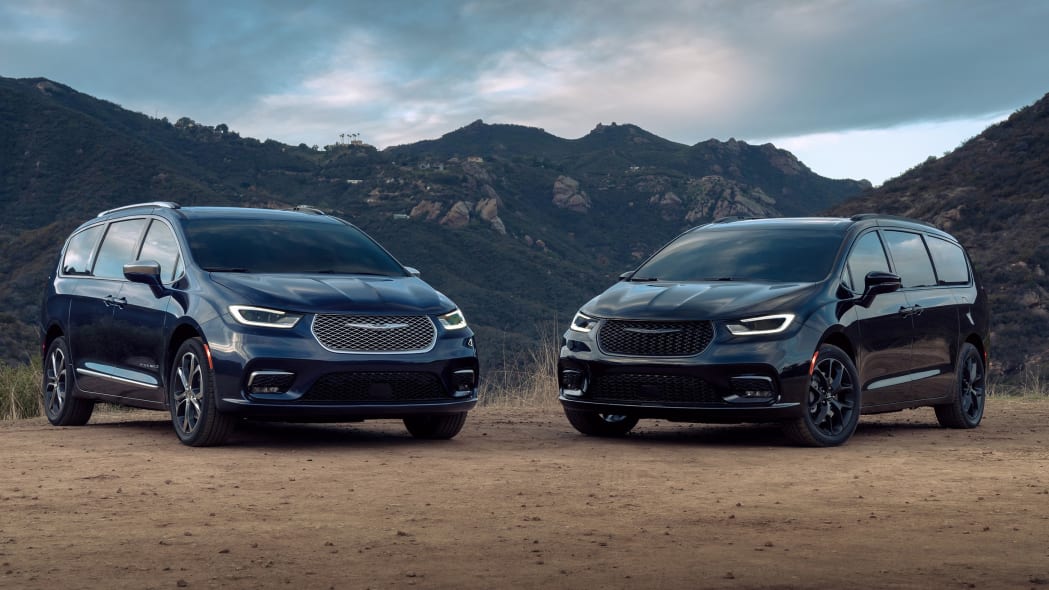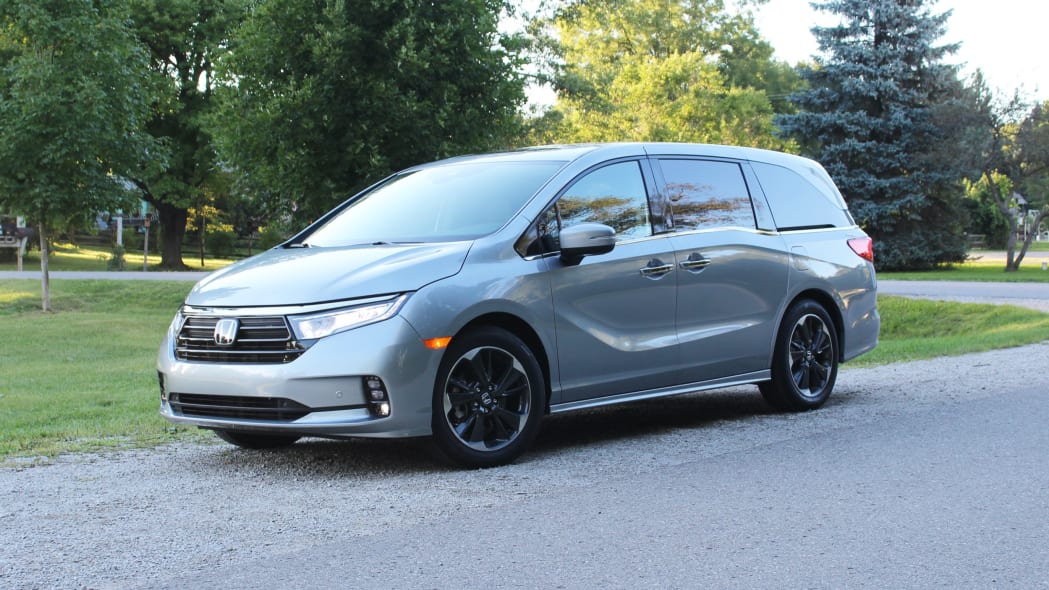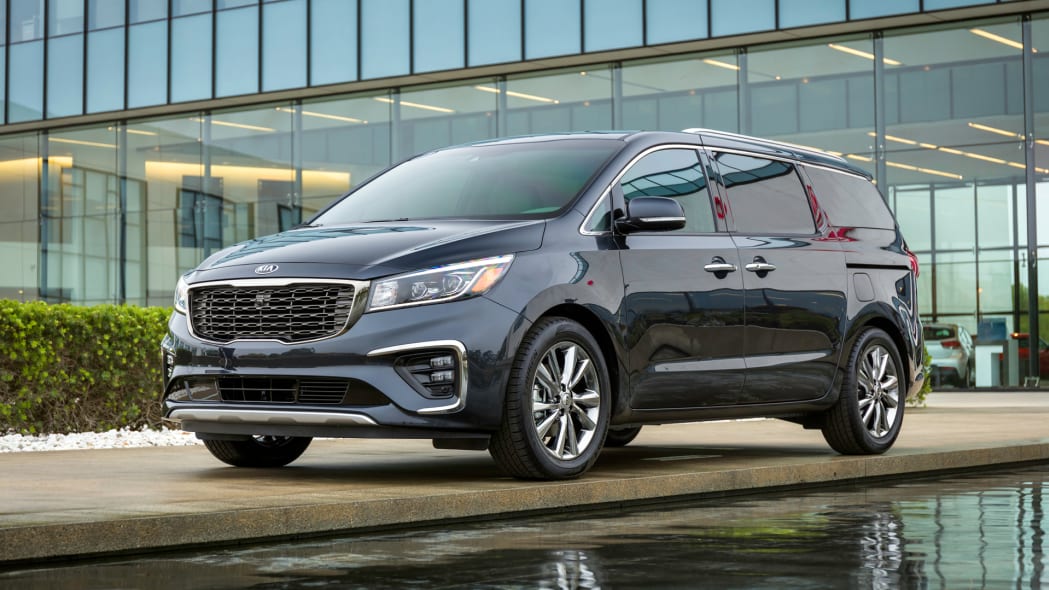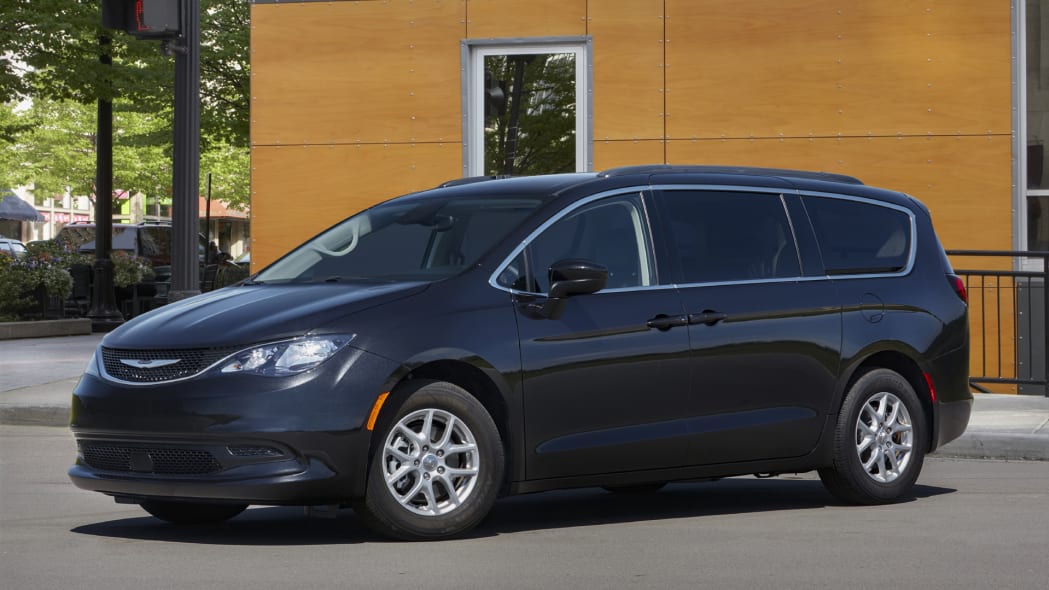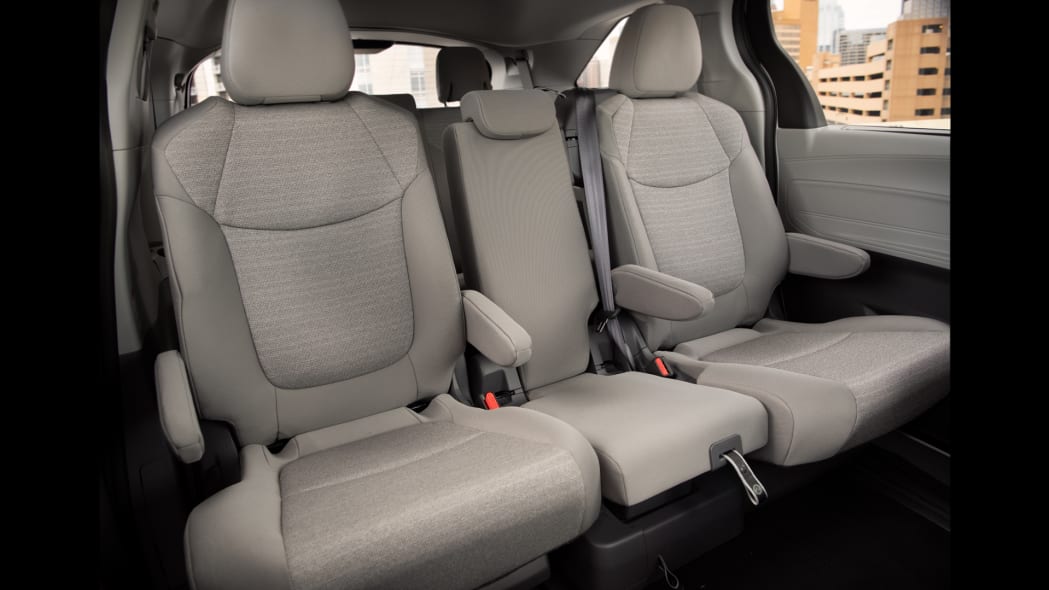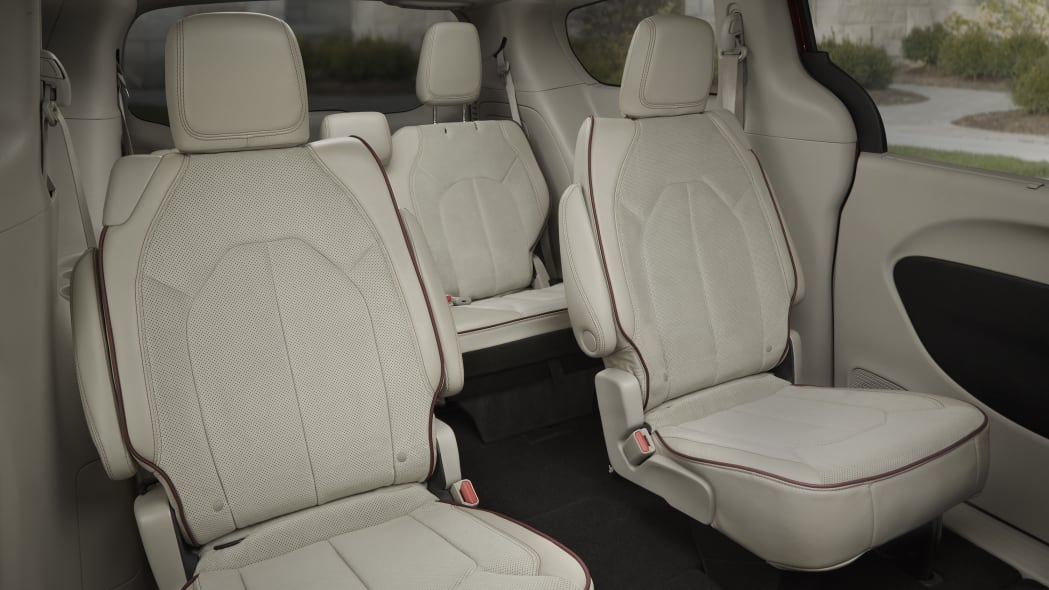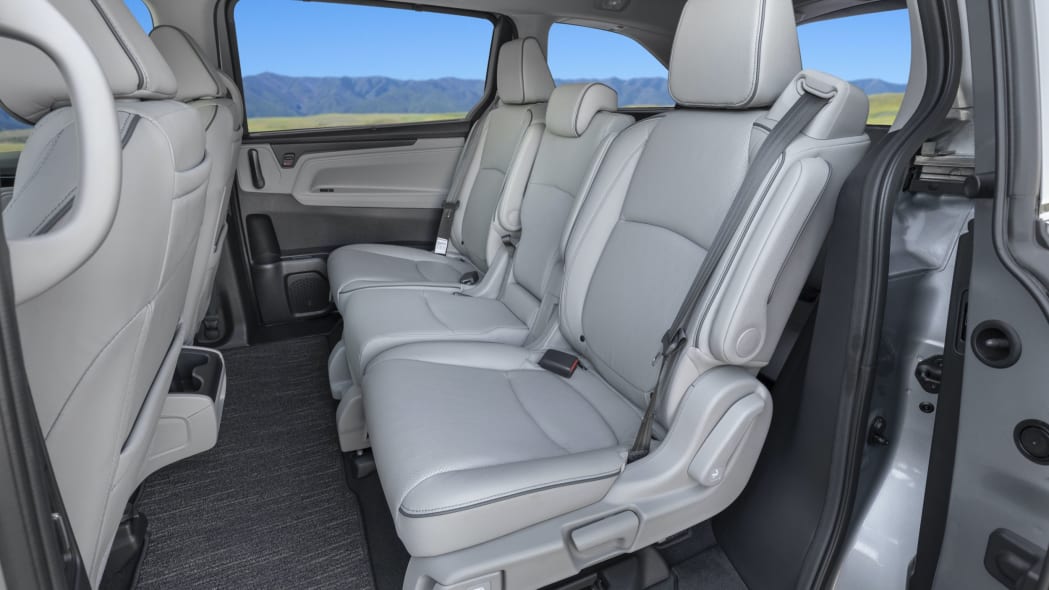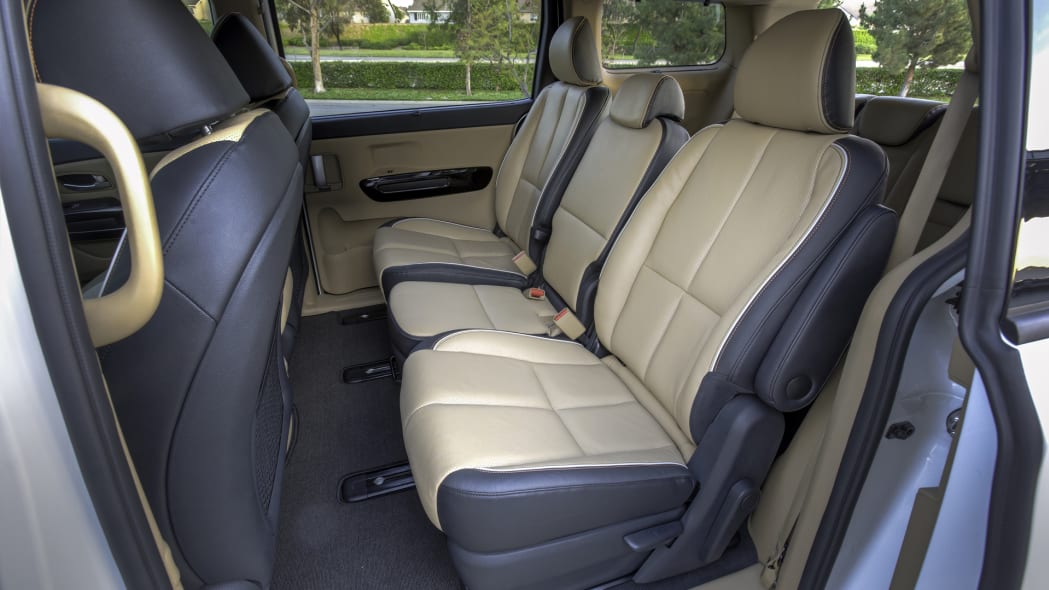The minivan segment is fresher than it’s been in years, possibly decades. The 2021 Toyota Sienna is a completely redesigned model with a bold new look and standard hybrid powertrain. Both the Honda Odyssey and Chrysler Pacifica were refreshed for 2021 with updated styling, upgraded tech, and in the case of the Pacifica, newly optional all-wheel drive. Only the 2021 Kia Sedona soldiers on without changes; it’s still a solid van despite its advanced age and relatively few people buying it.
Usually when we put a comparison like this together, we have to pick and choose which vehicles to include (mostly because we can’t do some 15-car spreadsheet without utilizing 4-point font). In the case of minivans, there are only four. That certainly makes it easier to research and cross-shop in person without worrying that you might be missing out on something. It also makes it a bit easier to go beyond the usual spreadsheet and dig a little deeper than normal into the competitors. Let’s take a brief look at each.
2021 Toyota Sienna
The Sienna is completely new for ’21 after going a decade with only updates. Its exterior style is more expressive than before, but it’s the new cabin that really impresses — it’s far more car-like in appearance, but still offers the expected amount of abundant storage and functionality. Mechanically, the big news is that every Sienna is now a hybrid. Though down a bit on power compared to everything else, its 36 mpg combined (or 35 mpg with all-wheel drive) crushes everything but the Pacifica plug-in hybrid. This exceptional fuel economy and its far-sliding, big-kid-friendly second-row seats are its main selling points, but in every other respect, it’s fully competitive.
Read our full 2021 Sienna Review
2021 Chrysler Pacifica
The Pacifica gets its first comprehensive set of upgrades since it was all-new for ’17. The front end has been restyled, all-wheel drive is now an option and there’s a new Pinnacle range-topping trim. The big news, however, is its technology offerings. Every Pacifica now comes standard, as the Odyssey and Sienna do, with a comprehensive array of driver assistance technologies. Every trim also gets Chrysler’s latest UConnect infotainment system with a larger, 10.1-inch touchscreen and wireless Apple CarPlay and Android Auto. These are all welcome updates, but the Pacifica’s strongest selling point continues to be its plug-in hybrid powertrain that can go 32 miles on a charge, then turns into a regular hybrid thereafter capable of 30 mpg combined. It even handles better than the regular Pacifica. Government tax rebates make it much cheaper than its higher MSRP would indicate. It’s definitely the Pacifica to get.
Read our full 2021 Chrysler Pacifica Review
2021 Honda Odyssey
The Odyssey gets the least significant updates: a successfully restyled front end, a new center console, an extra USB port in top trims and upgraded driver assistance technologies. Otherwise, the Odyssey remains the most unapologetic minivan. There was no attempt to add sporty or SUV-like flourishes outside, while inside, the dash has all the visual appeal of a washing machine. The driving experience is similarly indifferent, characterized by loose steering and a pillowy ride (unlike earlier Accord-like Odysseys). It’s all about taking care of the kids, and from its clever Magic Slide second-row seat to the CabinWatch backseat “spy” camera, it does a masterful job. If there’s one objective downside, it’s fuel economy — the Odyssey just can’t match the hybrid Toyota and Chrysler.
Read our full 2021 Honda Odyssey Review
2021 Kia Sedona
The Sedona is the elder statesman here, having undergone its last redesign for 2015. Not much has really changed since then. On the one hand, it’s still just as spacious as ever, matching the other vans here, and is perfectly pleasant to drive. Its styling is arguably the most tasteful and/or least frumpy of the group, while its interior design is more akin to an SUV than a minivan. Its second-row seat even slides considerably fore and aft for greater comfort and cargo versatility, though not to the extent of the Sienna’s new Super Long Slide seats. And really, that’s the rub: The Sedona doesn’t do anything the others can’t. It also doesn’t offer anything that really stands out like the Sienna and Pacifica’s hybrid powertrain, the Odyssey’s Magic Slide second-row seat or the vacuum cleaner available in all three (just to name one such gadget). The longest warranty here, a low price and generous feature content are ultimately what should keep it on your radar. (Note that there’s a new Sedona coming soon.)
2021 Chrysler Voyager
We’re not going to discuss the Voyager much. In short, it’s a Pacifica with last year’s styling, less feature content and a rock-bottom price that makes it the cheapest minivan for sale. Its dimensions, V6 engine and overall driving experience are largely the same. So, although it has a different name, it’s not really a different van. Consider it mentioned.
Specs and dimensions compared
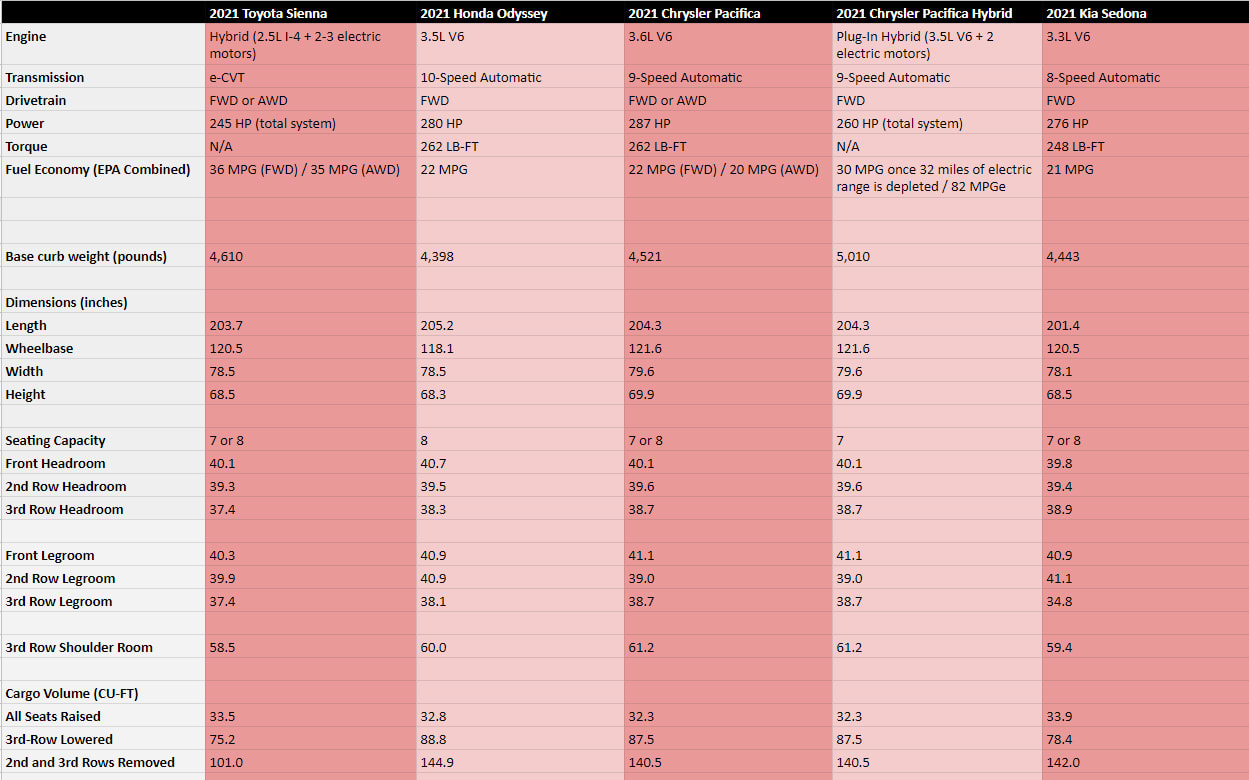
As you can see, the exterior dimensions of each minivan are incredibly similar. Sure, there are differences, with an inch advantage here or disadvantage there, but they’re all so big, it effectively doesn’t matter. Even passenger room is basically identical, with really only the Sienna having a slight disadvantage in terms of third-row head-, leg- and shoulder room. It also seems to have a massive deficit of cargo space when you start removing seats. However, we suspect this is actually the result of Toyota measuring cargo capacity differently than the others (possibly measuring only to the tops of the seats rather than all the way to the roof). The fact that it has similar cargo space behind the raised third row as well as similar interior headroom is strong evidence for this.
As such, the biggest difference between these four vans is what’s under the hood. As you can see, we broke out the Chrysler Pacifica Hybrid from the regular version just for the sake of spreadsheet legibility.
The Odyssey’s power and curb weight should in theory make it the quickest in the group with the V6-powered Pacifica closely behind. The Sienna has the least power and weighs more than all but the plug-in hybrid Pacifica, so it’s bound to be at the back of the pack. However, it shouldn’t feel that slow thanks to its electric motors providing some initial oomph off the line. The same can be said of the Pacifica Hybrid, although with its 32 miles of all-electric range, its oomph will last a lot longer.
Second-row seating concepts
Besides styling and feature content, the greatest differentiator between these vans’ interiors is their second-row seating concepts. Let’s take a look at each.
Toyota Sienna
The Sienna offers a choice of two second-row configurations. The eight-passenger model is probably better suited to parents with smaller kids since it comes with a removable second-row middle seat that you can affix a child seat to while keeping the outboard seats open. The seven-passenger setup found on upper trim levels features the new “Super Long Slide” second-row captain’s chairs, which slide further than its competitors by a considerable amount. Slid to the rear, they provide enough legroom for NBA forwards to kick back and relax. They also slide forward all the way to the front seats, making it more likely to fit whatever you need inside without moving the seats (while being more comfortable than the Chrysler Pacifica’s Stow ‘N Go seats). A second lever folds the seat cushion up and the seatback forward to either provide an easy ingress into the third row, or to maximize cargo volume even further. The Sedona offers something similar.
Chrysler Pacifica
The Pacifica (and Voyager) feature Chrysler’s Stow ‘N Go second-row seats. These captain’s chairs fold away into the floor, not unlike the third rows of all these vans. This lets you quickly transform your van from people carrier to stuff hauler without giving yourself a hernia lifting seats out. The downside is that the seats themselves aren’t as comfortable as the second-row captain’s chairs found in rivals. The Pacifica’s eight-passenger configuration adds a small seat between the captain’s chairs that does need to be physically removed. That element is similar to what you’d find in the eight-passenger Sienna and Sedona.
The Pacifica Hybrid does not have Stow ‘N Go, however. Basically, the giant hole under the floor that the seats stow and go into is filled with batteries. On the upside, its sliding and reclining captain’s chairs are more comfortable since they don’t have to be capable of origami.
Honda Odyssey
The Odyssey also has two second-row concepts, though the fixed second-row captain’s chairs are only found on the base LX. Every other Odyssey comes with Honda’s clever “Magic Slide” second row that we cover in this dedicated review. Basically, it’s a pair of captain’s chairs that, when the middle portion is removed, can slide laterally. This allows you to move them together to one side (making it easier to access the third row) or into the middle of the van (which is safer in the event of a side impact). Plus, you can move them all about without disconnecting child seats. Of course, you can treat them like regular captain’s chairs, though they admittedly don’t slide fore and aft as those in the Sienna and Sedona do, making them a better bet for parents with younger kids than older, taller ones.
Kia Sedona
The Sedona’s second row is pretty much the same in concept as the Sienna’s. It has an eight-passenger version with a removable middle portion, and then a seven-passenger version with outboard captain’s chairs that slide further than the Pacifica’s or Odyssey’s. Those can be upgraded further with comfy pillow-like headrests and pop-out recliner-style leg rests, which are neat but you have to be pretty short to full take advantage of them. The Sienna offers something similar, but thanks to the “Super Long Slide” seats living up to their name, the leg rests should be more useable for more people. Of course, when we start talking about the relative comfort differences between La-Z-Boy style seating, you’re probably in good shape either way.
Features and pricing
It’s important to look beyond base price since each van’s base model starts off with a different amount of equipment. For instance, the base Sienna LE and Pacifica Touring L have roughly the same equipment and price as an Odyssey EX — its second trim level. However, Chrysler offers the Voyager, which is a Pacifica with last year’s styling, rental-spec equipment and the lowest price of any minivan (even its LX “upper” trim level costs less than the Sedona’s base trim level). As for the Sedona, it’s an outlier, as its trim levels don’t really align with the others in terms of price or equipment. It’s also not available with as many fancy convenience and tech features as the Honda, Chrysler and Toyota, which helps explain why it never goes much higher than the SX trim’s $41,500 price tag. The others, meanwhile, can easily crest $50,000.
Then there’s the Pacifica Hybrid (Chrysler really makes this complicated). It clearly has the highest price, starting at $41,490, or nearly $5,000 more than the comparable regular Pacifica Touring. However, its all-electric range means you’ll be spending on average $550 less on fuel every year than the regular Pacifica, according to the EPA, but even that’s hugely dependent on how much you can plug in. The more you run on electrons, the more money you save. Then there’s the matter of government tax rebates. There’s a $7,500 federal tax rebate and many states offer more, meaning that the Hybrid can ultimately be cheaper than the regular Pacifica (or even the base Sedona). It’s just one of the reasons we so strongly recommend the plug-in hybrid Pacifica.
You can find a breakdown of each van’s trim levels, features and pricing using the links below.
2021 Toyota Sienna trim levels and pricing
2021 Honda Odyssey trim levels and pricing
2021 Kia Sedona trim levels and pricing
2021 Chrysler Pacifica trim levels and pricing
2021 Chrysler Pacifica Hybrid trim levels and pricing
2021 Chrysler Voyager trim levels and pricing
Conclusions
So, which minivan is the best? Well, it’s definitely not the decontented Voyager or the seven-year-old Sedona, but even those are actually really good vans. You’d be wise to check them out, especially if getting the latest gadgets and gizmos isn’t a top priority. That said, the real shopping should be done comparing the Sienna, Pacifica and Odyssey as they are clearly the upper echelon. All in, we’d probably choose the Pacifica Hybrid for its unmatched all-electric range, surprisingly good handling, handsome style and all the family-friendly goodness that makes the regular Pacifica so good. You just have to be prepared to wait for that hefty tax refund.
